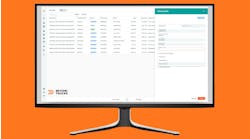Mills Carter, director of analytics for YellaWood – a $1 billion lumber company – recently made an extremely straightforward case as to the value proper data analysis can offer trucking companies.
YellaWood operates a 200-truck private fleet and works with approximately 500 outside motor carriers to haul its products in a regional market that spans from Texas to Pennsylvania “and everywhere south of that line,” he explained during a presentation at the McLeod Software 2017 User Conference in Atlanta, GA, this week.
Carter explained that data often “gets caught up in buzzwords” like Blockchain and “machine learning.” But he stressed that at its heart data analysis is really about using available information – even third party information, such as weather data – to improve fleet operations.
For example: YellaWood uses weather data to determine whether or not a load of plywood will need to be tarped. “Tarping takes time and work, but if a load of plywood gets wet, it’s a $30,000 loss,” he said. “So if the weather shows even a 10% chance of rain on a route, we tarp the load.”
How about using data to reduce driver turnover? YellaWood found that often the most profitable loads were not necessarily the “best” ones for its company drivers – taking them on long-haul routes that could be better served by YellaWood’s contract carriers. Two years ago, the company set up a capacity and costing optimization program that established “go/no-go” geographic zones established in part by tapping U.S. Census Bureau data for its private fleet; allowing it to determine when using a contract carrier would be a better option.
End result: More home time for the YellaWood’s private fleet drivers, with turnover falling from 55% in 2015 to 7% today.
“I had a driver come to me and say that, for the first time, he could coach his daughter’s softball team,” Carter said.
In terms of operational savings, YellaWood also saved about $1 million over the last two years using it's new system as well.
Mauricio Paredes, vice president of information technology at flatbed carrier P&S Transportation, which operates 1,200 trucks, noted during the panel discussion that using data the way YellaWood does is all about “working smarter, not harder.” But he stressed that trucking companies “must go where the data leads them, not where they think it is going to lead them. Your goal is to generate actions and make choices based on correct facts.”
Reports generated from trucking data can also be overwhelming so Paredes emphasized that it needs to be “broken down into bits and pieces” for each department within the company.
“Just give each person the slice of data they need to do their job better,” he noted. “And we prefer ‘leading’ metrics rather than ‘lagging’ indicators. Leading metrics helps elicit more proactive action.”
Paredes also pointed out that data “is not the sole source for making the right decisions” but helps provides more “visibility” for that decision-making process to occur.
Brent Engbrecht, director of business systems for flatbed carrier E.W. Wylie Corporation – which operates a fleet of 300 tractors and 425 trailers and is a subsidiary of the Daseke family of companies – added that that not only does data “ultimately provide for better decision making” it allows all of the decision-makers within a trucking company to operate from the same page.
“If everyone is looking at the same information, then you can coherently talk about what is happening with the loads you are hauling,” he said.
“You don’t know what you don’t know without data. For example, the highest paying load may not be the best option for the particular asset you are tagging it to,” Engbrecht explained. “Rate per mile, deadhead, miles per gallon, idle time, and tolls along a particular route – all of those numbers gives everyone a single snapshot to look at and make adjustments. For example, the number of tolls that need to be paid on a particular route may call for an adjustment in pricing. That has a big impact on profitability.”



